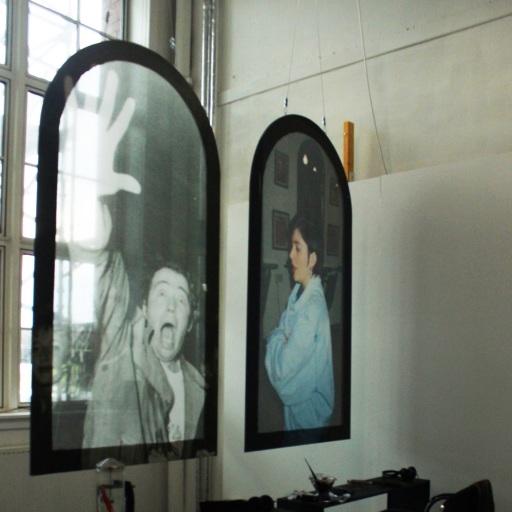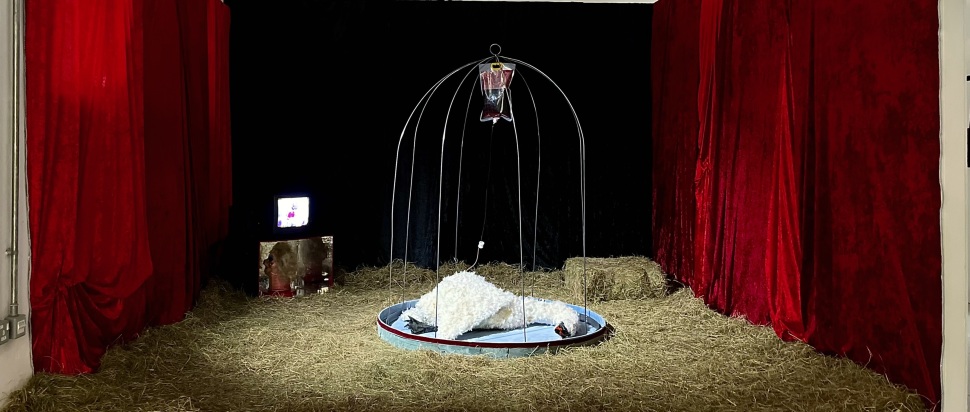GSA Degree Show 2024: School of Fine Art
As the role of art in the current climate feels both more trivial and more necessary than ever, students in the GSA School of Fine Art’s Stow Building deal with ideas around the politics of space, memory, personal and collective history and culture
These Fine Art students are looking back to the past to attempt to piece together an unstable future. Here the romantic is posed alongside the realities of our time.
Artists on the Sculpture and Environmental Art programme showcase a body of work that speaks of their experience of the ups and downs of creating and the nature of time, representing a state of flux.
Exploring the dissonance and unresolved relationship between our ‘speaking selves’ and physical embodied selves, Joe Cameron’s meticulously crafted stop-motion animation, Island of Forgetful Folk, sings of themes of subjective experience and the constructed self through the eyes of a character whose memory is externalised in a series of notebooks that detail his past. Ancient spaces and archetypal settings function as metaphors for the external and internal self as we are invited to consider our own phenomenological experience of life.
Also considering a means of preserving memory and looking to the past, Sancia Brims creates a sonic representation of a space familiar to many locals and GSA students, offering a display that resembles a contemporary archive, reflecting on the history of the current arts and music venue The Old Hairdressers, the site where her parents once operated a salon in the 1980s and 90s. An enduring hub of energy and party culture, she constructs an interpretation of what it might once have been like.
Out on the third and fourth floor landings, Mike Hill is casting a watchful eye over the Stow stairwell, with his lighthouse nodding to the inevitable passing of time with the words 'Inspite of you it revolves’. Somewhat more serious than his past satirical approaches, Hill’s work represents an inquiry into the nature of being alive, while reminding the viewer that the work would be there even if they were not. This ‘memento mori’ acts as a second part to a statement in Hill’s earlier work: 'The world outside is exactly how you left it, spinning uncontrollably.'
Tamsin MacArthur’s work is driven by the inevitability of failure, channelling this through a mixed-media installation that recounts (while also being made in anticipation for) a pilgrimage to the Holy Isle in a coracle that is fated to sink. ‘Things going wrong’ are mythologised through fragments of walls and arches resembling ruins. The viewer is left to explore the space as they choose – the archway refusing its assumed function as a gateway.
Theodora Koumbouzis Maclellan’s kinetic shadow puppet installation references original beginnings (be those biblical or mythological). We are given a choice between whether to buy into the initial flattened image and experience of innocence, or the sickness of the complexity of the mechanics and the material realities of the ‘puppets’, driven incessantly by a motorised mechanism spawned from a rusted barrel. The original innocence of the romantic and theatrical is contradicted by the material – the mechanised contraptions commenting on the metronomic nature of life and history.

Sculpture and Environmental Art by Sancia Brims.
Laurie Knott’s feature film is a culmination of brewing ideas around the idea of success and its entwinement with creativity, starring and celebrating those that have shaped his degree in one way or another. Playing on the idea of what it is to be at art school – that one should know what one is doing – and the notion of being a director, Knott strikes a balance between romanticisation, and the poignant truth of committing to the inherent vulnerability of creating.
In Painting and Printmaking, students have been grappling with current global issues, subverted fantasy stories and archetypal cultural tropes. Eerily yet undeniably relevant, Liz McNeill's paintings portray abstracted compositions of congestion, dissipation, and fragmented figurative elements that emerge from layers of oil, acrylic and gouache, implying something brutal and bodily. While encouraging viewers to derive their own interpretations and meanings from her works, she also addresses a central concept of moral injury, rooted in her own experiences as a cardiologist during the pandemic and AIDS crisis. This perspective informs her search for release in the present, as she addresses suffering in Gaza and considers more broadly where organisations intended to provide care often lack the necessary support from the very structures in which they operate.
Meghan Josephine's paintings depict a type of female representation that stands apart from any recognisable environment. The works compel you to focus on the interactions between figures and the ways in which they occupy each canvas – outstretched, slouching, and feeling their way through space. However, this is no 'reclining nude', and Josephine's work arises from an exploration of women's representation, influenced by her experiences in America during the reversal of Roe v Wade.
Inhabiting a fantasy world in the darker and lighter senses of the word, Iona Jones’ kinetic sculptures delve into the seductive darkness of fairytales, her irreverent and witty use of materials reminiscent of child-like experimentation. The viewer's suspension of belief is exercised as she depicts surreal moments of animal transformation and fragments of stories. Fairy tales are seen to be a lens through which to moralise the world, as much now as in childhood. A caged swan bleeds five litres of blood throughout the show; a wolf-dog-man’s head, mounted to the wall, dribbles into a dog bowl – all is wonderfully and bombastically unexpected.
A more sombre exploration of fantasy comes into play in Eve Wilbrahams’s emotionally impactful, thoughtful large-scale paintings. Intimations of the elusive character of Pierrot surface on the canvas, through a playful and soulful use of texture, his collar seemingly floating in the space. The romantic is posed alongside the melancholic, courageously forging paths of light across the surface, alluding to Pierrot’s intrinsic relationship with light. Textural qualities across the works feed into each other as much here as when the works were being created side by side within the space.
Similarly exploring the boundless qualities of paint, working reflexively between painting and analogue polaroid photography, Lucas Allan imitates specific tonal qualities in a mixture of oil, acrylic and airbrush. Apparitional forms appear shimmering on the surface as the viewer anchors on an enigmatic yet familiar form that slowly and hazily emerges.
Drawing together the similarities between self care and improvement and domestic labour, Ruby Stewart’s love seat-come-gym bench-come-ironing board-come-gossip chair invites you to sit (or lie) within the space. Head-to-head, you are given, with another, the nesting space to have an intimate conversation, surrounded by imagery that would usually lend itself to capitalist structures, but instead serves as a subversive antidote to the isolation of gym culture.

Work by Painting and Printmaking student Iona Jones
This year the Fine Art Photography programme Degree Show deals with the politics of space and cultural identities, as well as notions of their ownership.
Maya Schønning Kjærulff’s digital weavings present us with scenes depicting an unseen process of removal. A series of rooms that once contained people, all derived from digital sources, evoke questions of private and public space. The works explore the boundary between what viewers can see and what remains hidden, a theme reflected in the increasing abstraction of each image as one gets closer. Through a digitally produced process, the artist examines algorithms and the removal of information, resulting in works that are both sensitive and intimate.
Similarly, toeing the line between private and public, Matilda Reid’s monochromatic etchings and screenprints on glass and steel depict window views taken from porn sites. Questions of ownership are raised, framed through her window, through a stranger’s, the window functioning as a liminal divider between the exhibitionist ‘being seen’ and the voyeuristic ‘seeing in’. The glass prints speak of the fragility of the image and the situation, further encroaching on the private. Two monitors sit facing each other recounting intimate yet universal silent conversations between the well-acquainted and well-accustomed, the contents of which becomes slowly identifiable through their gestures.
Mia Gwenllian is showing a series of suspensions, some sculptural, composed of found objects, threads, and two-tone cyanotypes with hints of ancient Welsh language. These elements evoke themes of personal and collective grief, exploring the loss of cultural inheritance, with her installation also including a large silk fabric print, dyed with tea and colour prints mounted on reclaimed wood, arranged dynamically on the wall. Gwenllian’s work presents a unique narrative that entwines past and present.
Primal ancestral heritage is poetically delved into by Freya Cookson. Spawning from a moment where she was struck with a gut reaction of fear, and a sense of the passage of time, while entering a cave in an Aberdeenshire town connected to her maternal family, Cookson displays a series of large format negative prints of the site. Mother speaks of time immemorial, belonging, personal roots and seeking geological belonging. One photo depicts a visit to a neolithic stone with her mother and her mother, finding solace in the permanence of stone, and how geological features have shaped people and cultures.
Brogan Vandenio‘s highly ambitious period feature-length film is an idiosyncratic ode to his working class family and upbringing. Vandenio’s work seeks to pursue a truth within his identity, drawing primarily on the relationship of brotherhood (his brother Riley Anderson plays the lead) and explores the idea of a child coming to terms with the reality of his family and origins. Using his own archive footage of a period spent in Venice before the concept of the film had fully germinated and a fictionalised home in Scotland, thanks to an eclectic bunch of friends it is a celebration of his time spent film-making.
School of Fine Art Degree Show, Stow Building, 31 May-9 Jun
